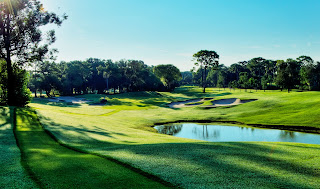Defending champion Paul Casey will attempt to become the only back-to-back champion in Valspar history, and will tee it up against field that includes 10 of the top 30 players in the Official World Golf Ranking (OWGR), including World No. 1 Dustin Johnson and No. 10 Jon Rahm. Only four of the 18 defending Valspar champions have finished in the top-10 the following season.
Number 5
Inside the Field In addition to fielding 10 of the top 30 players in the world, the 144 man field includes nine of the top 30 players in the FedExCup Playoff standings (led by Gary Woodland at No. 5) and four FedExCup champions (Jim Furyk in 2010, Bill Haas in 2011, Brandt Snedeker in 2012, and Henrik Stenson in 2013).
The field also includes nine past Valspar champions: K.J. Choi (2002, 2006), Jim Furyk (2010), Gary Woodland (2011), Luke Donald (2012), Kevin Streelman (2013), John Senden (2014), Charl Schwartzel (2016), Adam Hadwin (2017), and defending champion Paul Casey (2018)
Number 4
Leave Your Driver at Home
Things can go wrong in a hurry if you pull out the driver at Copperhead. With tight, tree-lined fairways and a bevy of doglegs, look for a majority of the field to use less-than-driver off the tee. Because positioning off the tee will be more crucial than distance on this 7,340 yard, par-71 track, you'll see a lot of long irons and even fairway woods coming into the greens on a few of the par-4s and par-5s.
Considering the distance players will be approaching the greens from, it's crucial they play from the fairway as the greens are generally small and tough to hit. The putting surfaces are fast and undulating, and putting or chipping from the wrong spots will bring certain trouble.
Number 3
Copperhead Restoration
To ensure Copperhead remains a great test of golf for years to come, the course was restored in 2015 to honor the guiding principles of famed course architect Larry Packard and his masterful design. Each green was rebuilt to USGA specifications and several were restored to their original larger sizes to allow for more pin placements.
Putting surfaces now feature a new strain of TifEagle Bermudagrass, while the fairways were seeded with Celebration Bermudagrass for greater shade and drought tolerance and recovery. A new state-of-the-art irrigation system will save 11 million gallons of water per year.
Number 2
Unconventional Layout
Copperhead is an unusual layout, featuring four par-5 holes and five par-3 holes. There's only a 20 yard difference between the shortest and longest of the par-3s, but a variety of green shapes, protections, and elevation changes make them all very challenging.
The 4th green is wide but shallow, while the 8th green is deep and narrow. The 13th green features the only forced carry over water, while the 17th green is protected by bunkers and trees perching over both sides. And wind is almost always a factor,which makes things even more difficult.
The four par-5s at Valspar are the most difficult par-5s to score on outside of majors. Since 2014 birdie average on the par-5s is dead last, and eagle average is second-to-last.
Number 1
Snake Pit
Hole Nos. 16, 17, and 18 are collectively known as the "Snake Pit." and historically rank inside the top-5 toughest group of finishing holes on Tour. Look for stirring theater and high drama coming down the stretch on Sunday. The entire right side on the par-4, 475 yard 16th hole is a watery grave, and for those who manage to stay dry the approach is even tighter.
The par-3, 215 yard 17th hole is all about the green, and club selection will be crucial to finding the right spot on this enormous putting surface. While No. 18 is an uphill par-4, 445 yard hole with a narrow tree-lined fairway that's flanked by bunkers on both sides. The green is severely undulating and the most treacherous on the course.







No comments:
Post a Comment